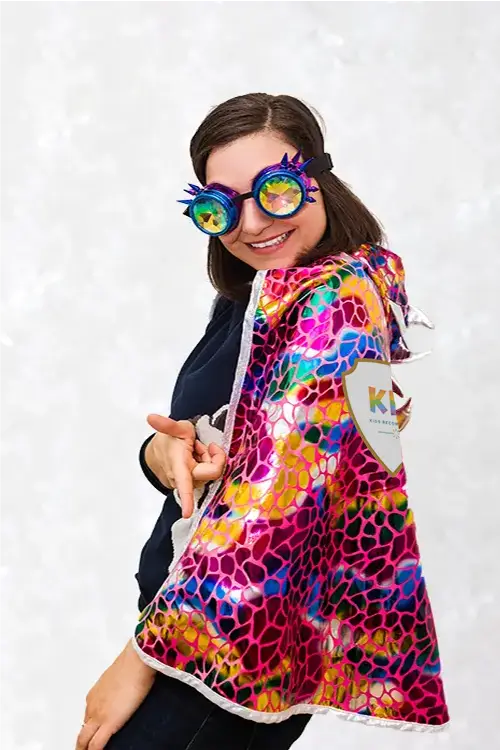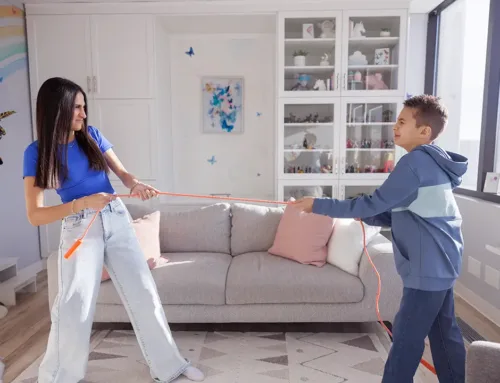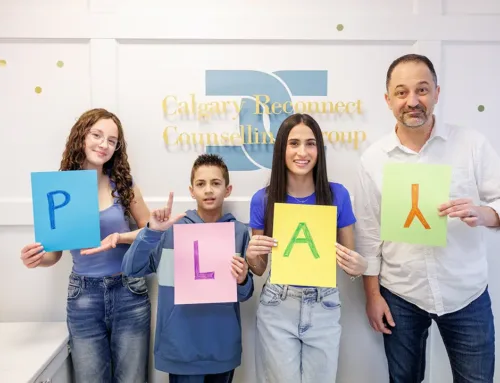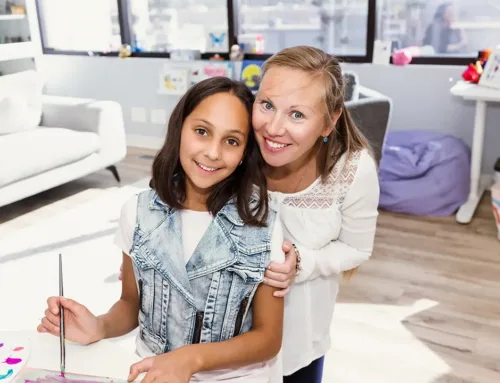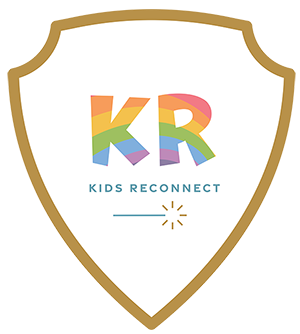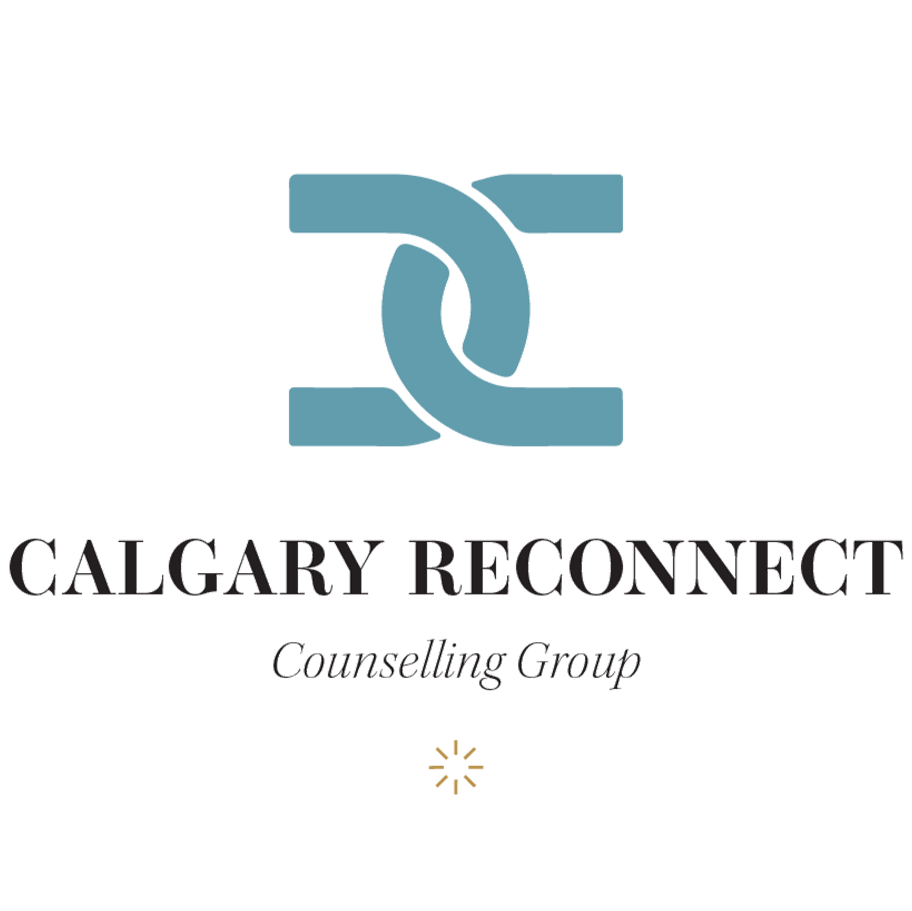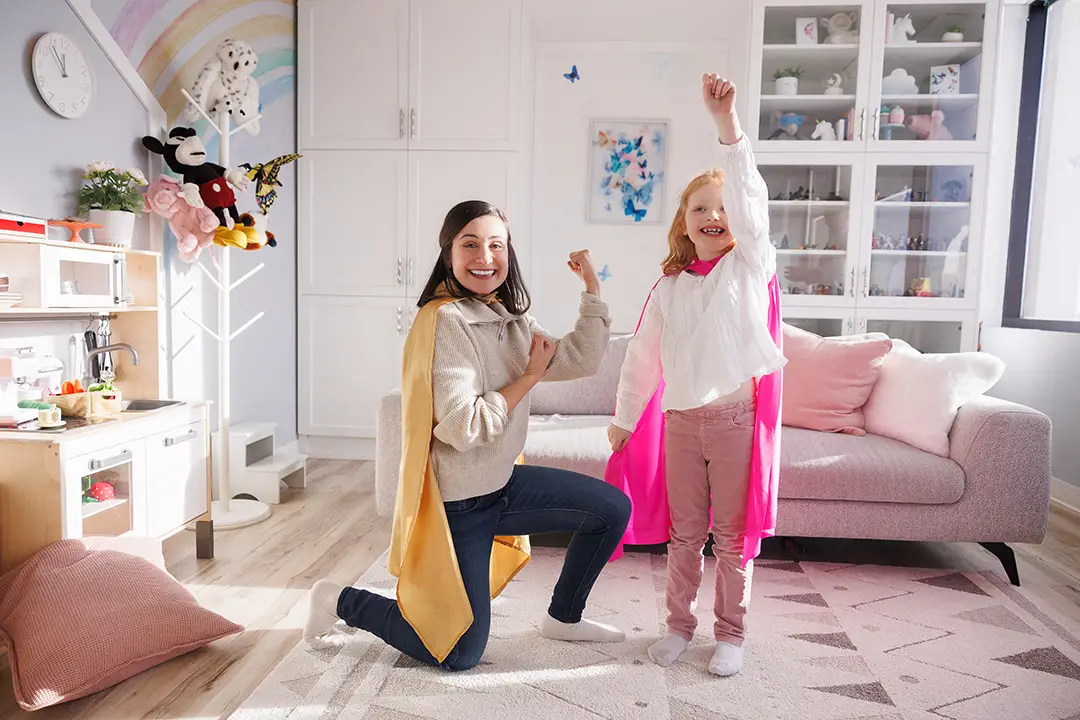
Tips for playing with your child across different ages and stages of development
In this blog post, child psychologist Marcella Galizia shares some fun ideas to help parents
connect and support their child them through play
This blog post is based on a presentation that Marcella conducted at Knocked Consignment,
a local Calgary consignment store that hosts regular free coffee chats for parents of young children.
Check them out at knockedconsignment.com
Questions that parents often ask play therapists
Why is play important? Why should I play with my child?
Play is essential to children’s brain development across different developmental stages.
PLAY = learning and communicating. Kids learn through play. Play helps kids in many ways. It:
- Helps them tune into sounds and rhythms of language (especially for babies and toddlers)
- Deepens parent-child connection and bond (across different developmental stages and ages)
- Improves social skills and functioning (across different developmental stages and ages)
- In later developmental periods, more complex play, like “pretend play”, can lead to divergent thinking, narrative, increased spatial reasoning skills, problem solving skills, and improved social and emotional functioning.
- Plus, play is fun!
Common parental concerns and barriers to play
- “I don’t have time. I’m too busy with home or work related responsibilities.”
- “I don’t know how to play with my child” or “I don’t know what I am doing!”
- “No one ever played with me.”
- “I didn’t realize it was important!”
- “I would look silly.”
Different types of play
- In the baby years and toddler years, play is in everyday interactions with objects and people. It is in song, dance, and movement.
- Constructional play (construction blocks, building sets)
- Fine motor (colouring, miniatures)
- Gross motor (jumping, dance, sport)
- Pretend play (imaginative play)
- Scripted or text play (video games)
Play therapy is just play, right?
Yes and no. Play therapy is play, but it is much more than “just” play. Children express themselves through play when they can’t verbalize, “I am mad at you” or “I am fearful to get into the car because of the loud noises.” Play therapy allows children to externalize problems or emotional experiences that cannot be talked out like adults may do. It is the job of the play therapist to help a child deepen, expand, and elaborate on their play sequences or themes, to build meaning and deeper understanding of the child’s internal world.
But if it’s play, it doesn’t mean anything, does it?
Yes and no. Anything that is repetitive or consistent in play may highlight an area that the child is working on or trying to address through play. If it is significant, it may present as a theme and show up across a series of sessions rather than just one single isolated play incident.
Any play therapist will do, right?
Yes and no. Play therapy is an advanced specialty, with only a few providers in Calgary having this full certification or designation. Further, to certify in play therapy requires advanced training, supervised practice, on top of already being a therapist, registered social worker, and/or registered psychologist.
In summary, not just any friendly face will do, but play therapists are usually friendly.
Any toy will do, right?
Not really.
At Kids Reconnect, we are highly selective about the toys we stock in our child therapy playrooms. We ensure that our child clients have access to a wide selection of high quality toys that can support emotional expression, cultivate curiosity, foster inclusivity, reflect different family structures and different lived experiences (like grief/loss, bullying, parent-child conflict), or exposure to different environments (reflected in materials like sand, rocks, or other aspects you would find in the real world), as well as cultural considerations (race, ethnicity, language, religion, etc).
Play across different stages of development
First: an important note about child development
Every child, baby, or toddler develops differently, at their own rate and pace. Each child’s developmental path is unique.
If you introduce a toy or object to your child and they seem disinterested at first, try it again at a later time. Babies need multiple introductions before they may engage with something new.
If you have concerns about your child’s development, reach out for support from a trusted professional who is trained in the area of child or developmental psychology. Pediatricians and physiotherapists are also great sources of professional support.
It can be hard not to compare your child, baby, or toddler to others, but we strongly recommend doing yourself a favour and trying to stop making comparisons that create fear, anxiety, or stress in you.
Instead of comparing, we suggest you try to:
- Attune to your baby or child. What do they need from you?
- Focus on what interests your baby. What objects or toys appeal to them? What nursery rhymes and songs appeal to them? What household objects appeal to them? What catches their attention?
Playing in the baby years (from birth to 1 year old)
What is play at this stage of development (0 to 1 year old)?
- Within the first year of life, there is extraordinary brain growth and development. Your baby’s play skills, abilities, and interests are constantly evolving from month-to-month or within very short time spans.
- From observation, watching, looking (in earlier months, typically 1-4 months) to motor and sensory play involving manipulation, experimentation, and investigation of objects or toys (in later months, 5+ months).
- It can involve body, sensory, balance, and movement.
How to play with your child at this stage of development (0 to 1 year old)?
Playing in the earlier months (1 to 4 months old)
Welcome to the world! Everything is new for newborns (and new parents). Babies are this stage are interested in exploration with their mouths. They recognize caretakers are grow more social (3 months), seeking your smiles, and they develop better eye control (following objects).
Play activities with your 1-4 month old
- Black and white toys (or high contrast images are preferred (due to the baby vision).
- Framed mirrors.
- Soft books.
- Crinkle bags.
- Play gyms (tummy time).
- Sound makers (rattles).
- Teething toys or teething rings (or any other safe objects that they like to explore with their mouth).
- Splashing in the tub.
- Kicking balloons (my favourite supervised activity).
Playing in the middle months (5 to 8 months old or so)
Tracking objects, aware of changes in tone, curiosity about environment
Play activities with your 1-4 month old baby
- Sounds:
- Locating sounds (click fingers, move around their ears for them to turn their head from side to side)
- Sound makers like rattles (or any household object for that matter, such as the loose leaf tea shaking in the tin).
- Soft sounds, loud sounds for differentiation.
- Imitate their sounds and let them hear it back (good sense of attunement and mirroring).
- Music, dance (nursery rhymes, singing and dancing with your baby).
- Banging objects together.
- Dropping soft, safe objects from the air (like scarves) or from your baby’s hand.
- Movement:
- Wobbly toys (that encourage reach, kicking, grabbing).
- Balls: Roll back and forth, hide under a blanket (object permanence).
- Splashing in the tub.
- Social interaction:
- Looking at eyes and mouth (make exaggerated facial expressions when telling a story).
- Imitation: waving, “hi” and “bye” (wave your hands and let them watch), clapping.
- Hide and seek (with objects) or peek-a-boo.
- Chasing (when they are crawling, you can move around a table, other furniture) .
- Looking in the mirror (they won’t know it’s them until about 18 months).
- Real life:
- Containment, filling cups with or without holes in it. Putting a scarf inside, pulling it out (with a container with holes, scarf comes out and a container without holes, the scarf stays inside).
- Narrated house tours (flicking lights on and off, opening and closing cabinet doors, exploring a spoon and bowl, or parent’s car keys).
- Watching moving objects like trains, dogs and cats.
Playing in the later months (8 to 12 months old or so)
Cause and effect in the environment becomes intriguing. Small details are noticeable and interesting. Learning about feelings, object permanence, and shape. Growing better coordination and concentration. Understanding spatial relationships.
Play activities with your 8-12 month old baby
- Toys: Same toys already mentioned, they are still fun but now your baby may use them in new ways. For instance, books have pages to turn or move upside down.
- Sounds: Making silly sounds (yours, or your baby may start to make on their own.) Mirroring and differentiation.
- Exploration and Investigation
- Simple puzzles, 1 piece (if you can’t find any, create something yourself :) – problem solving
- Texture cards (learning what things are)
- Nesting or stacking cups (parts of a whole, containment)
- Water play: Ice cubes on tray, explore different senses (warm, cool, cold). Explore change (solid to liquid). Of course, this is a supervised activity.
- Fill a bag with oil or water, add colour and let them push on it and watch the colour / water move around the bag (again, supervised activity but so much fun!) Swish, shake, and toss the bag and watch the colour.
- Interactive games: Peek-a-boo or bouncing on your lap
- Real life:
- Back and forth conversations. They “talk” and you mimic their sounds or respond back (serve and return).
- Small spoon and cup to experiment with during meals, or whisks and pastry brushes, which are fun for babies to play with during playtime.
- Explore soft hair brushes or tooth brushes during their morning routine.
- Nature walk. Get your baby close to things like trees for close examination. Show them flowers, explore scent, shape, and of course, beauty.
Other play ideas and playful activities to consider across the baby years
- Check out Montessori play kits, geared to each phase of development by month (0-2 months, 3-4 months, 5-6 months, 7-8 months, and so on).
- Read books to your baby. This builds connection, language, and brain development. Read one book at bedtime each night, if possible. You can make it part of your sleep routine.
- Show your baby pictures of them at different phases (or even of other babies, they love looking at babies), point out their body parts and then turn to them and name their own body parts. This builds language skills too.
- Want to play some more? Consider social programming. Check out the Calgary Public Library for classes like Baby Rhyme Time or join swimming classes with your baby.
- Looking for a guide on your baby’s behaviour? Check out “The Wonder Weeks” by Hetty van de Rijt.
Sustainability tips for the baby years
- In the spirit of sustainability, consider reusing and find local consignment stores part of your Calgary community.
- Repurpose your baby’s toys, such as sensory books. Shift them from just touch: from “seeing” books books to ”feelings” exploration in later years. Feelings are often somatic, so these books are a great way to expand social-emotional literacy in later years. Hang onto these books.
- Bored of the same book? Mix it up. Read it in a silly voice or add your own child name to the story. Count pictures and graphics on the page. Make the same book fun again.
- No need to purchase expensive toys. Instead, consider making your own. For example, use ribbon from the dollar store to create your own textured strips for your child to feel with their hands. Have containers? Let your child at them so that they can understand the concept of containment. Let your child into your plastic container cabinet.
- Use toys in different ways. Containers can become bath toys: add water and now they take on a whole different meaning and purpose.
- Anything in the home is interesting to your little one. No need to spend lots of money with tons of everyday objects or home spaces to explore. Of course, keep your baby under supervision while exploring new areas (especially those that aren’t baby proofed yet).
- Home tours are a great way to build curiosity and have fun with your little one. A new room is full of adventure and exploration for your baby.
- Allow them to explore everyday objects like pots and pans. For instance, you can make drums and focus on the sounds: loud beat, soft beat or hard beat, fast beat, etc). Or you can turn your lights on and off, or explore scent in the home (not too strong, of course, but smelling some flowers in the garden, tea bags, and soft or gentle mists).
- Seasonal fun. In the summer, rub on the sunscreen and repurpose your baby bath to make an outdoor swimming pool. Fill with bath toys, throw in your containers, some bubble bath, and put on your baby’s swimsuit and the water play is on. Collect twigs and leaves in the fall, flowers in the spring, or play in the snow.
- Show and narrate to your baby what is happening. For instance, crinkle up paper to show a transformation (“see the soft paper, listen to the crinkly paper, look at the change!”).
Playing in the toddler years (1 to 3 years old)
What is the 1-3 years old stage about?
- Emerging sense of self (“I am strong”), usually tied to behaviours (“because I can pick up my own bag”), and usually overly positive (“I am stronger than a lion!”)
- Comparisons to their younger self (not likely to other children).
- All-or-nothing thinking.
- More body control.
- Growing from the “Terrible Twos” to the “Cooperative Threes”. There is a shift from not liking and stubborn attitudes in relationships to cooperative and easygoing attitudes in relationships.
- They can identify themselves as “unique”, with thoughts and feelings separate from those of others.
- Understanding the idea of “mine”, “his,” and “hers” (at about 3 years old).
What is play at the 1-3 years old stage of development?
- Manipulation, experimentation, and investigation.
- More body, sensory, balance, and movement.
- Parallel and associative play.
- Doll or teddy bear play (by 2 years old, the doll can do some things, by 2.5 years old the doll can “wake up”, by age 3, your doll is moving into a doll house, and at 3 and a half years old, the doll has qualities like naughty or nice).
- Life and body scripts. These play elements help your child understand how to perform everyday tasks like dress up, feeding, toileting. Play might involve “brushing teeth” or “feeding” a baby doll.
- From simple play, usually involving one action (rolling a truck across the floor, back and forth) to more complex ones with two or three actions (the truck stops at the store and then goes home).
- One pretend action, feeding the baby or other actions observed (mom making dinner, stirring food in the pot) to multiple pretend actions, then the baby goes poop and to sleep).
- Short role plays to longer..
- Books and storytelling.
Other play ideas and activities to consider across the toddler (1-3) years
- Check out community activities happening around Calgary, like nursery rhyme times or public swimming for your little one. Not only are these activities connecting for parents, but they allow you and your child to bond and regulate through music, song, dance, and physical activity. This is highly co-regulatory for you and your child.
- Make a book of exaggerated feelings faces (of your child), and read it to them. Not only does this build their emotional awareness, but it can be a fun and silly way to engage with them.
- “Free play” over screen time, please. Children should not be getting much screen time at this age.
- Playdates are more for parents at this stage, with kids wanting to be around and see others but there will not be much engagement on the same toys or play activities.
- Model play: feed your child’s teddy dinner.
- In the spirit of sustainability and community, if your child is bored with a toy, switch them out. Consider a toy swap or connect with other moms at a local consignment store.
Playing in the preschool years (3 to 5 years old)
What is the 3-5 years old stage about?
- Social comparisons (“I am good but Tommy is not.”)
- Two emotions (“I am happy and excited”). Difficulties differentiating thoughts and feelings from those of others because feelings are not observable.
- Overestimating their own abilities.
- Toys are viewed as extensions of the child opposed to external entities, which makes sharing very hard for them to understand. Little sense of possession, as in all things are for them.
- 5 year-olds try out relationships with parents first, making future peer relationships or more complex relationships more possible in later years. If children develop secure attachments with one or both parents, they are more likely to develop secure relationships with peers as they grow.
What is play at the 3-5 years old stage of development?
- Stories and storytelling.
- Play plots and subplots.
- Several play roles (momma can do this, this, and that, like work, cook, be the driver).
- Cooperative play, negotiating in play (this is mine, you take this one).
- Pretend play (fairies, animals, etc), dress up, kitchen, “babies”.
- Play scripts around everyday activities.
Other play ideas and activities for the preschool years (3 to 5 years old)
- Do they like dolls or teddies? Take their doll or teddy everywhere, like on family trips, and capture pictures of their doll or teddy at the places your child visits like a theme park, grandma’s garden, etc. At this stage, the doll has their own character and a “life of its own”.
- In the spirit of consignment, consider purchasing second-hand outfits for dress-up play. Find items that children can use to “take on roles,” like an apron to become a chef.
Playing in the school age years (6 to 12 years old)
What is the 6 to 12 years old stage about?
- Their emotional worlds are expanding. They begin to grasp that other people have different feelings than theirs.
- Expressing internal states and emotional experiences.
- More complex ways of thinking. Concrete to abstract thinking.
- Applying causality to situations and events, meaning they can make sense of their experiences.
- Capable of mentally representing objects with symbols (making play therapy a good option for them).
- Growing gross and fine motor skills, making smaller toys accessible and becoming more proficiency in dance and sports).
At 5 to 7 years old, your child:
- Enjoys and feels secure in parental relationships.
- Is able to take interest in parents and peers.
- Plays independently from parents and asserts themself with peers.
At 8 to 12 years old, your child:
- Begins to grow their autonomy and independence.
- Their world is other kids, but family is still important to them.
- Participates fully in peer groups and is aware of their roles.
- Concerned mostly with friends.
What is play at the 6-12 years old stage of development?
- Board games (or games that are rule-based), sports and team activities.
- Competitive activities or competitions. They want to win and be the best at everything.
- Text play, scripted play, video games.
- Pretend play takes on a more complex form, with more sequences and deeper meanings.
Other play ideas and activities for the school age years (6 to 12 years old)
- Enroll your child in extracurricular activities that spark their interests and build their natural curiosities and abilities (physical, emotional, intellectual, and relational Superpowers). Popular activities include: swimming, soccer, piano, book club.
- Join in your child’s play and enjoyment. Don’t always make it about “teaching”.
- Make up your own character, who takes on a persona or an identity (give them a job or role in the play), and characteristics (like “funny,” “smart,” “kind”), and possibly challenges to overcome (like “bossy,” “rude,” or “fearful”)
- In the spirit of sustainability, find second-hand games that your child may want to play (no need to always buy new) and take your child to the Calgary Public Library to rent out books or meet their favourite local author at a book reading. Yes, “old school”, I know.
Playing in the preteen and teen years (13 to 18 years old)
What is the 13 to 18 years old stage about?
- Emerging identity and independence.
- Making mistakes.
- Exploration.
- Testing limits and boundaries.
What is play at the 13-18 years old stage of development?
- Video games (discord to play with peers).
- Social media and texting friends
- Style and dressing up.
- Peer friendships: hanging out, socializing, texting, “snap streaks”.
Other play ideas and activities to consider across the teen years (13 to 18 years old)
- Connecting with teen on preferred language, in playful or silly ways. Explore the cool slang of your teen years, with your teen’s slang or language. In my teen years, “’S UP?” or “WHAZZUP?” was very popular, and the word “sick” was used to convey a likeness for something (and not an illness). What about now? You might notice your teen using words and expressions like “slay,” “squad,” or “sus”. These expressions go in and out of style very quickly in the adolescent world.
- Engage with your teen on similar or common interests.
- Encourage their friendships, making healthy and safe choices
- Connecting with your child’s style is very important at this phase. Understanding their “vibe” and how they dress is very important to their self-differentiation and identity development. What does this mean? Notice how they dress, take interest in their hair styles (different colours, right on), as well as their clothing choices. Yes, it means going shopping for fun. Old trends are coming back, making thrifting “sick” (my generation) or “lit” / “gucci” (in today’s teen terms).
Grow your playful parenting Superpowers with us
Follow along as we expand this blog series, designed to help build parents’ Superpower parenting skills. For example, do you know what your PLAY style is?
Meet the author
It takes a community
Parenting is hard, but you don’t have to do this alone.
We encourage parents to connect with other parents in the Calgary area,
whether new or experienced. We all have something to give and something to offer.
Turn to other parents for their wisdom and guidance, and build or join supportive spaces and places to stay connected.
If you are looking for a child psychologist in Calgary to support you and your child grow and thrive,
our team of child therapists is here for you.
